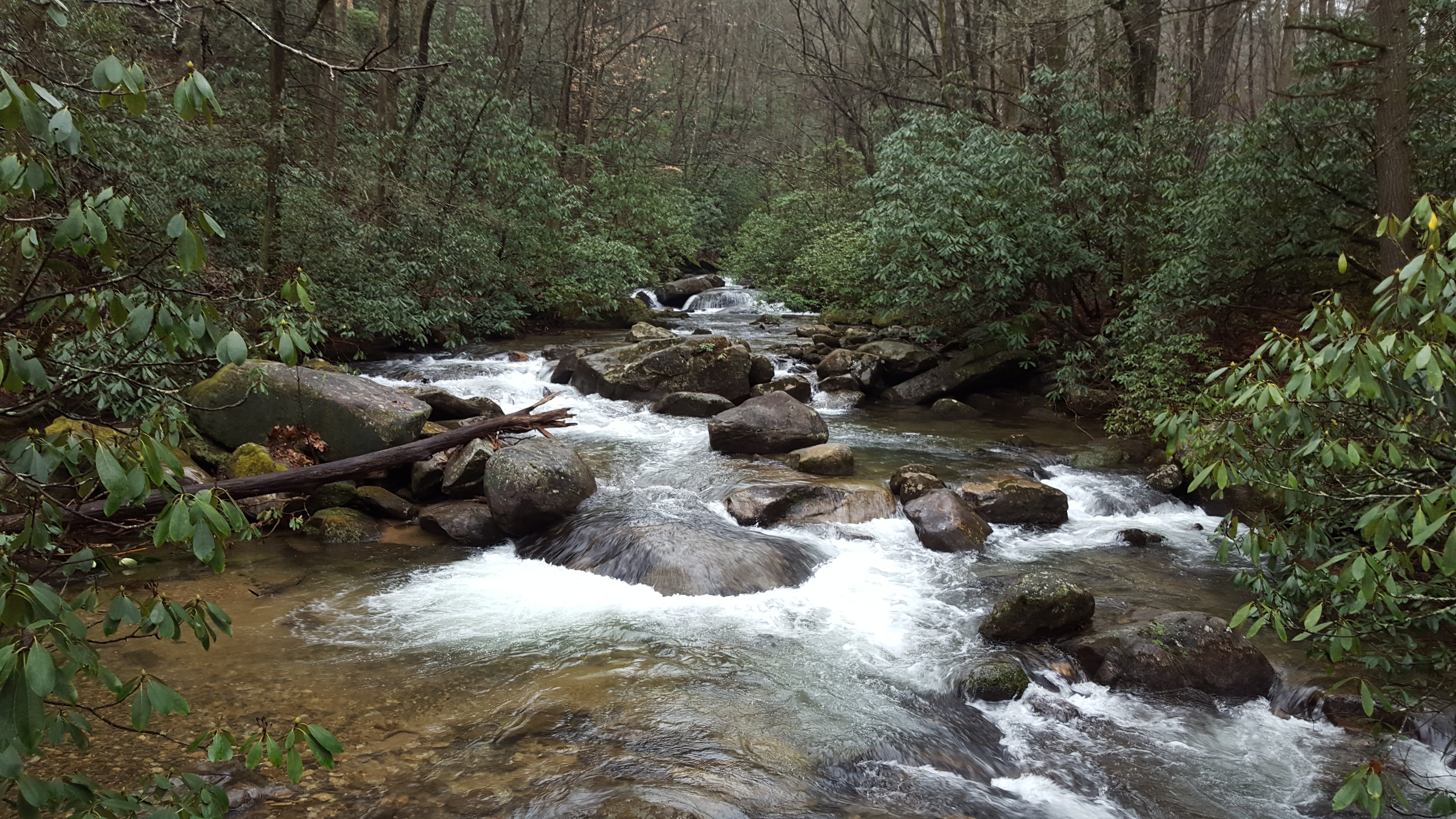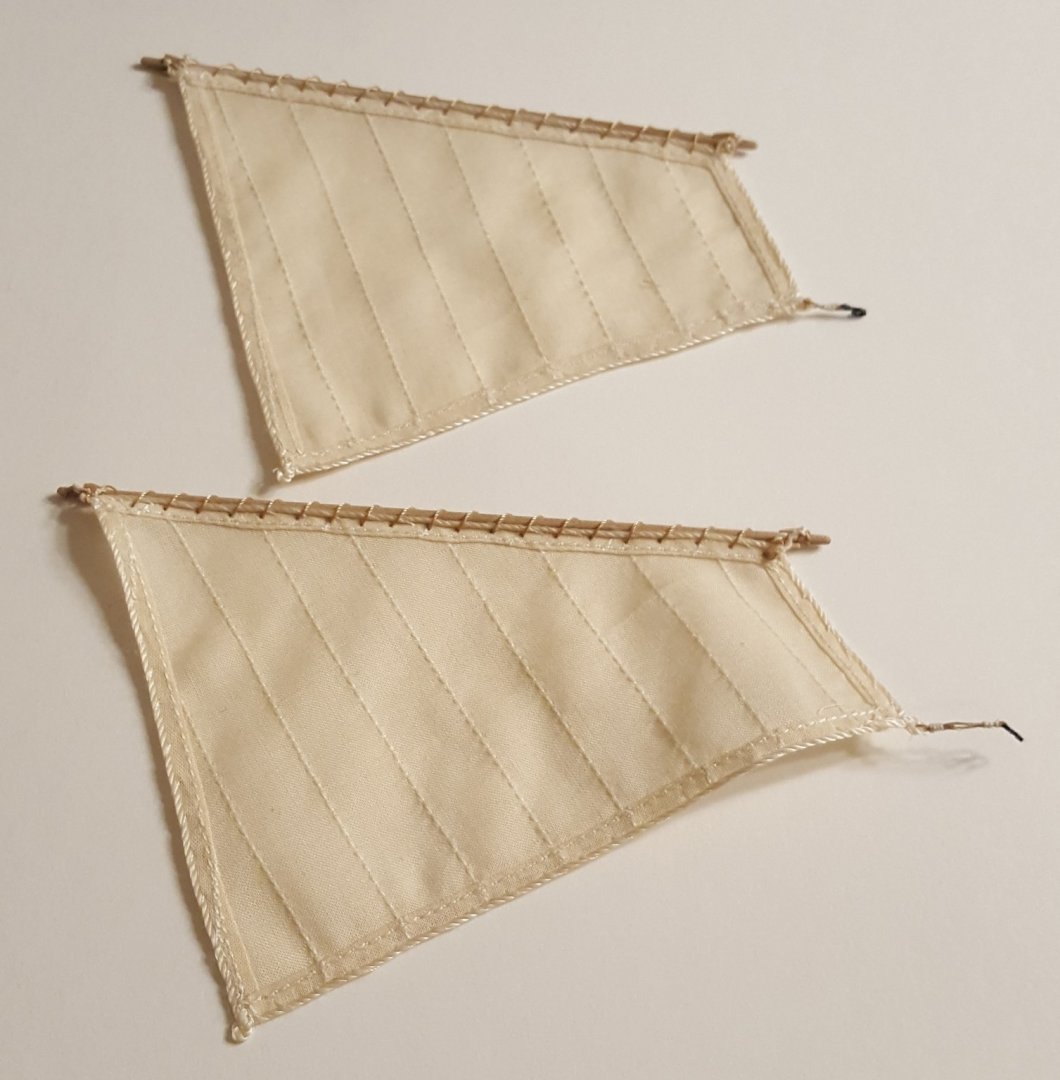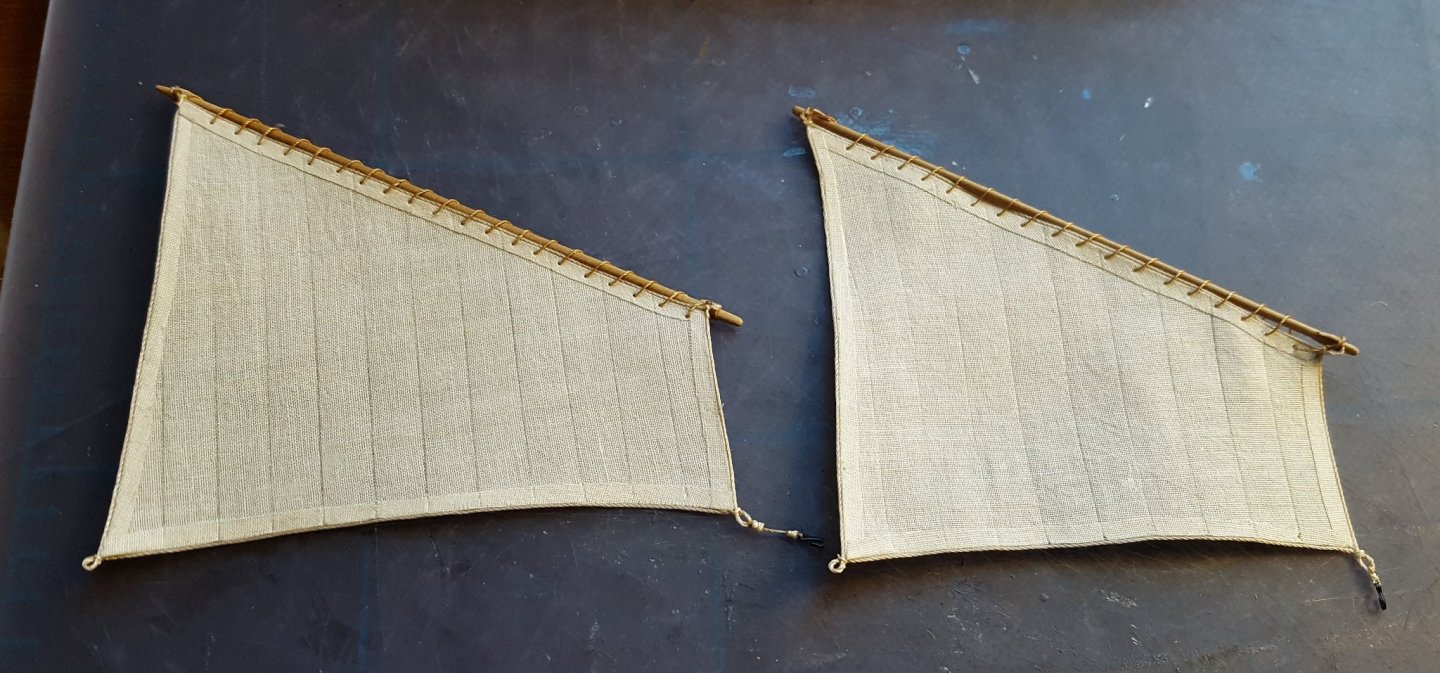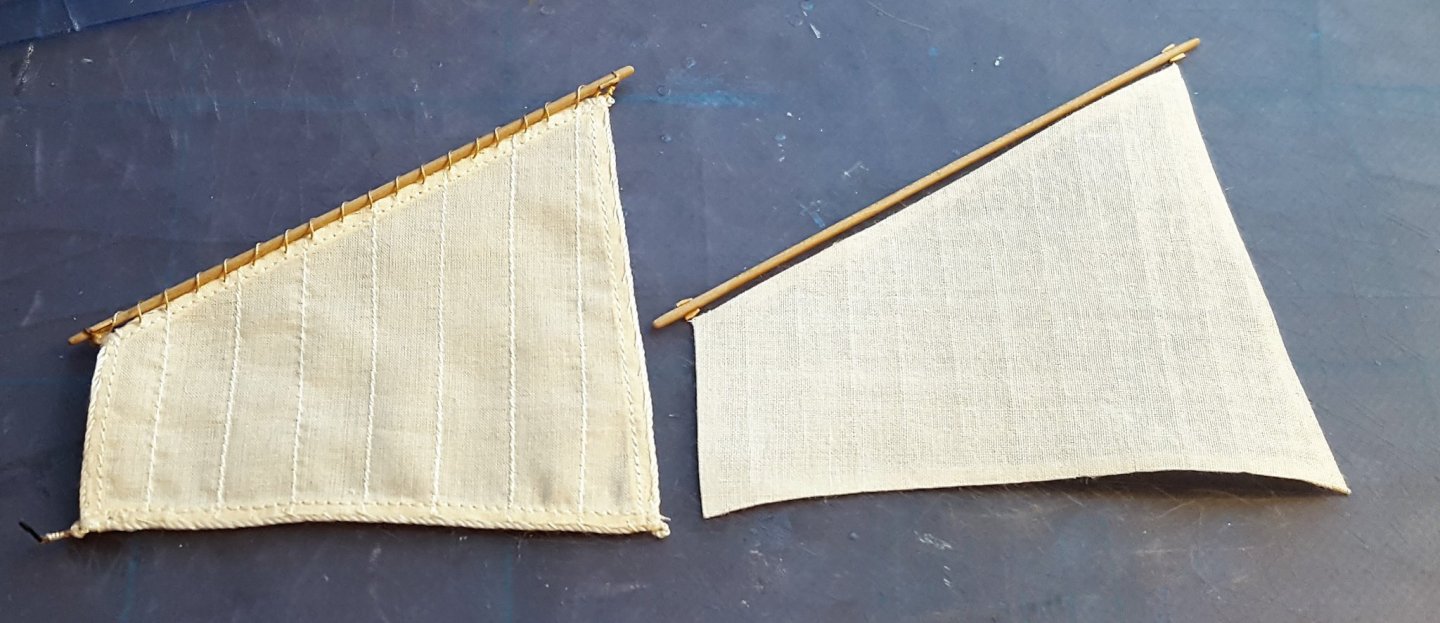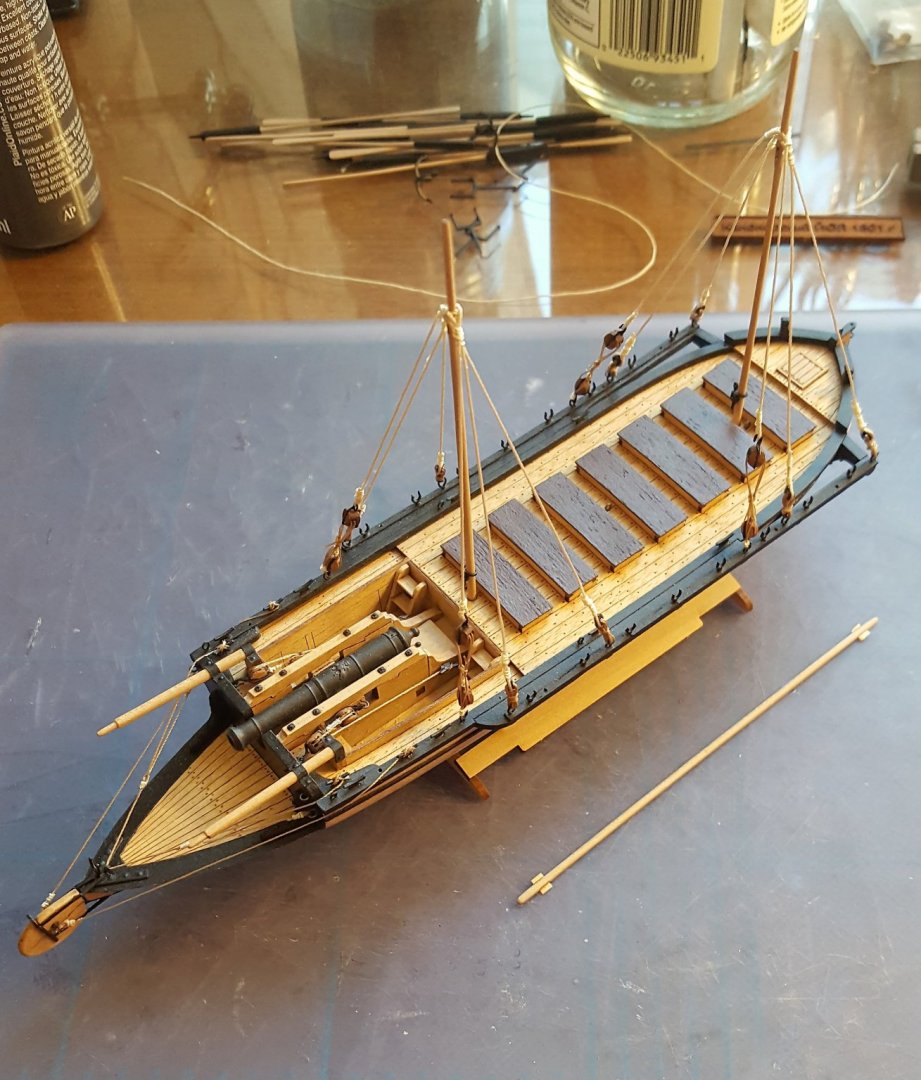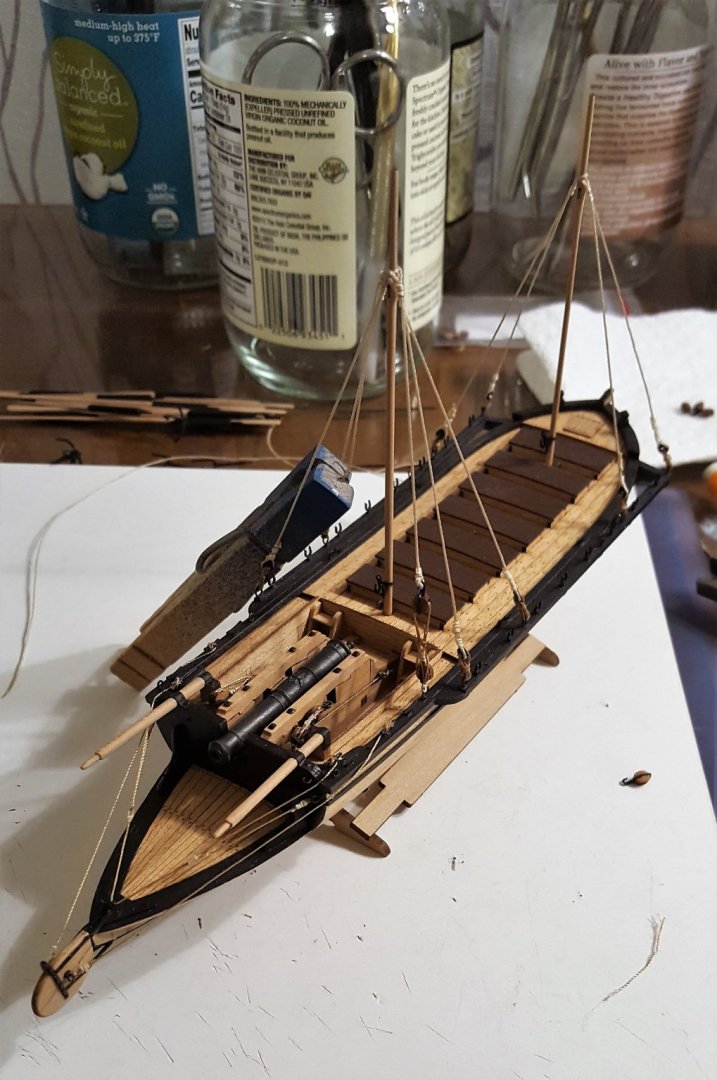-
Posts
10,496 -
Joined
-
Last visited
Content Type
Profiles
Forums
Gallery
Events
Everything posted by ccoyle
-
Nothing tricky -- just cloth and glue. Hems are folded and glued. If I make bigger sails, I glue on the appropriate panels around the edges & reef point bands. All glue, no stitching. Bolt rope is glued, too.
- 117 replies
-
- 117 replies
-
I'm glad that you're giving some thought to upgrading the guns. Your hull is looking quite nice and is worthy of some better-looking armament. Cheers!
- 195 replies
-
- enterprise
- constructo
-
(and 1 more)
Tagged with:
-
Okay, too late for the furled sail question -- I already made the new sails. It's not hard to do; I just didn't want to do it. But now they're done (though no bolt ropes yet and not bent to yards). On the left is the pre-sewn foresail, and on the right is the new sail. One of the things I don't particularly like about pre-sewn sails is that the stitching is always way out of scale, therefore I don't sew. Instead, I glue everything up. Also, panel lines are barely perceptible on real-life sails, except where adjacent cloth pieces are color-mismatched. So, I lightly penciled the panel lines on the aft side and scored them, which gives just a hint of lines on the front. BTW, for cloth I used one of my last remaining bits of drafting linen -- might have been my last piece. And here's Maisy, the suspected sail-eating culprit. She's so darn cute and lovable that it's impossible to stay mad at her. 🥰 Cheers!
- 117 replies
-
Well, I understand completely about not having one's heart in a model, but still I would lean toward stripping off the copper and going for the white stuff, which was known back in the day as "white stuff." Like Glenn said, you could easily sand down that hull. After a nice paint job, no one would have a clue about its thrice-done history. Cheers!
-
All shrouds and backstays set up. Replacement main yard under construction. Before I get too far with that last bit, I'm wondering how these small boats would have dealt with furled sails. Would they have furled the sails and then re-hoisted the yards to keep them out of the way of rowers, or would they have lowered them to the deck? Asking for a friend. 😬
- 117 replies
-
Oh, I have done them before -- I just didn't want to this time around. 🙂
- 117 replies
-
This imitates the method used on the full-size boat. The idea is that the model can serve as a kind of inexpensive dry run.
- 39 replies
-
- northeaster dory
- chesapeake light craft
-
(and 1 more)
Tagged with:
-

Polish PZL P.11c by ErnieL - IBG Models - 1/32 - PLASTIC
ccoyle replied to ErnieL's topic in Completed non-ship models
Nice! I have this one in 1/33 card from Halinski -- it's so beautiful and detailed that I'm afraid to booger it by actually attempting to build it! -
Welcome! Your models look perfectly presentable, and bear in mind that our community of "literal experts" includes large chunks of beginners and otherwise middling modelers who nevertheless simply enjoy the hobby. You will, for example, never find one of my models being labeled as "built by an expert," but I take satisfaction in them. Enjoy the journey!
-
Chris Watton is a cutting edge designer with a long track record of great kits. Speedy will be challenging, but doable for a motivated builder.
-
Welcome, Ernie. I think I may have visited the large scale modeling site a time or twos some years back. If memory serves, "large scale" was defined as 1/32 or larger, and 1/33 scale card planes were acceptable thanks to our European compatriots fondness for metric scales. Cheers!
-
In reality, the front wheels were larger to compensate for the deck camber (downward curvature from the centerline to the bulwarks).
- 195 replies
-
- enterprise
- constructo
-
(and 1 more)
Tagged with:
-
Unmitigated disaster has struck. 😥😥😥 I had just finished setting up the remaining mainmast backstay and then was working on making the foremast backstays, when I happened to glance to my left. That's where I had the two sails waiting to be set -- only there wasn't two. There was only one. I didn't panic, because the sails had fallen off my desk before, so I just set about looking for the sail ... and looking ... and looking ... and looking. I looked everywhere, even following the old adage about looking where it couldn't possibly be. I scoured my entire modeling room three times. No sail. The only possibility I could come up with is that our one-year-old spaniel, Maisy, who likes sticks, came upstairs and helped herself. I thoroughly searched the house and yard looking for evidence. Nothing. It's gone -- vanished. I am beyond depressed. This was supposed to be a quick and easy build. I really don't want to scratch-build a replacement, because that defeats the whole "quick and easy" thing. Besides, if I make a new sail, it won't look like the other pre-sewn sail, so I'll probably have to make two -- plus replace the yard. And that will add days to an already overly-long build. 😟😟😟 I am really not feeling motivated right now. I thought I was nearly finished. Man ... just ☹️.
- 117 replies
-
Yes, no ratlines, hooray! And yes, the finished results don't look bad, but boy what a pain it has been to arrive at them! Also, since the model is quite small at 1/72 scale, it won't be readily apparent that the rigging line isn't Syren's finest, or similar, besides which I wanted to do this one as much out-of-the-box as possible to keep it cheap.
- 117 replies
-
Here's my progress to date. All the shrouds are set up, and I have the first back stay set up. You can also see that my work area tends to be very untidy while I work -- I just leave out all the tools I need at the moment, and it seems like I always need a lot! One tiny, tiny complaint I must file with Dmitriy and Evgeney: Guys, please please replace the rigging line in your kits! The line in this kit is as bad as the rest of the kit is good. I don't know what material it is made of, but it does not hold glue well, does not maintain a point when cut, frays easily, and is inclined to unravel at the slightest provocation. It has been very, very frustrating to work with. In fact, I stopped a little bit early tonight because I was about to lose my cool with the thread and knew I needed to step away before someone got hurt! Thanks for listening! Cheers!
- 117 replies
-
I am strongly leaning toward Wütender Hund as my next ship project, but will probably take a short break between ships to knock out a card plane.
- 175 replies
-
- hanse kogge
- shipyard
-
(and 1 more)
Tagged with:
-
Ooh, ooh! I know! Cuz I asked the same question not so long ago. 😉 He uses a self timer.
- 109 replies
-
- Vanguard Models
- Flirt
-
(and 1 more)
Tagged with:
-

Curtiss P-40B Warhawk by Asat- Airfix- 1/48
ccoyle replied to ASAT's topic in Non-ship/categorised builds
Forgive me for jumping late into the discussion, but this has been good reading! Actually, historian Stephen Bungay made a very compelling argument in his book The Most Dangerous Enemy that Germany effectively lost the war with the conclusion of the Battle of Britain. Having failed to eliminate Britain from the conflict and afterwards turning eastward, Germany was left with a two-front war with an enemy whose industrial and economic advantages Hitler could not hope to match. I love the discussions about relative capabilities of aircraft. I think most of us would agree that the early prevailing narratives about P-40s vs Zeros, etc., were based on early combat results, which in turn, as others have pointed out, were in large part the result of not using the equipment at hand to its best advantages, e.g. skilled pilots in P-40s and F4Fs were more than capable of holding their own against the Zero when using zoom-and-climb tactics. The P-40 also performed very capably against the Luftwaffe in North Africa (where low altitude performance was at a premium), and the RAF mostly maintained air superiority in that theater thanks in no small measure to the P-40's capabilities in the ground attack role. It's also very interesting to see how aircraft that are denigrated by many historians, of both the professional and armchair varieties, performed in the service of foreign nations. Soviet pilots (again in another theater where combat operations were mostly at low altitude and thus where superchargers were less critical) loved the P-39. Likewise, Finnish pilots loved the Brewster B-239, the export version of the Buffalo, and ran up fantastic kill records against Soviet types. Admittedly, their Soviet counterparts were flying mostly second-tier stuff, but the Japanese were still flying some A5Ms and Ki-27s in SE Asia early in the Pacific war, along with a variety of not particularly overwhelming light and medium bombers, so one suspects that if the British and Dutch had employed zoom-and-climb against the Japanese instead of trying to turn with them (which, after all, had worked against the Germans), they might have had more success with the Buff. As I think Lou pointed out earlier, the Zero's range and maneuverability were purchased at the expense of survivability and high-speed performance; the Japanese put all of their eggs into one style of air combat basket, with disastrous (for them) results. Once their initial corps of highly skilled airmen was depleted, they had no chance of competing with the manpower and production capacities of the Allies, no matter how good some of their late-war designs turned out to be. Speaking of highly-skilled airmen (I can't resist tossing this last tidbit out there), there's a reason why 303 (Polish) Squadron of the RAF scored the most kills during the Battle of Britain. Our fondness for Polish jokes in the West has perhaps obscured for many the fact that pre-war Poland had a very rigorous pilot training program -- one of the most demanding in all of Europe. Few also remember that Poland had one of the most advanced indigenous aircraft design industries of the 1930s. Rigorous evaluation of the records has put paid to the notion that the Luftwaffe rolled the Poles up on the first day or two of the war. Poland's most advanced fighter then in service, the P.11c, had a better than 1:1 kill ratio versus the Luftwaffe, despite being slower and less heavily armed than its German counterparts (the Luftwaffe fared even worse against the Curtiss Hawk in the Battle of France). These are facts that tend to be more generally known among card modelers because of the foremost position of Polish publishers in the card portion of the modeling world. Okay, enough fun and games (and thread hijacking)! -
"Apprentice" is not perhaps the right term -- gave me some good tips though and got me past the fear of spiling. MSW was originally created by James Hatch, but its roots go back to a now-defunct forum called Dry Dock Models (DDM). DDM's focus was on wooden sailing ships, but Jim wanted to create a forum that was open to ship modelers of every variety, though some of us are still struggling to boost the profiles of plastic, card stock, steel navy subjects, etc. 😉
-
Don made an amazing model of the Sovereign of the Seas that started life as the 1/78 scale Sergal kit, from which he used only the hull formers, the rest being scratch-built based on a lot of research. It took him 10 years to complete. All of the hull ornamentation is gold-leafed. I wish we had some pictures of it here. In fact, I often wish that more of the SMA guys would join up here and share their work -- there were some great modelers in that group.
About us
Modelshipworld - Advancing Ship Modeling through Research
SSL Secured
Your security is important for us so this Website is SSL-Secured
NRG Mailing Address
Nautical Research Guild
237 South Lincoln Street
Westmont IL, 60559-1917
Model Ship World ® and the MSW logo are Registered Trademarks, and belong to the Nautical Research Guild (United States Patent and Trademark Office: No. 6,929,264 & No. 6,929,274, registered Dec. 20, 2022)
Helpful Links
About the NRG
If you enjoy building ship models that are historically accurate as well as beautiful, then The Nautical Research Guild (NRG) is just right for you.
The Guild is a non-profit educational organization whose mission is to “Advance Ship Modeling Through Research”. We provide support to our members in their efforts to raise the quality of their model ships.
The Nautical Research Guild has published our world-renowned quarterly magazine, The Nautical Research Journal, since 1955. The pages of the Journal are full of articles by accomplished ship modelers who show you how they create those exquisite details on their models, and by maritime historians who show you the correct details to build. The Journal is available in both print and digital editions. Go to the NRG web site (www.thenrg.org) to download a complimentary digital copy of the Journal. The NRG also publishes plan sets, books and compilations of back issues of the Journal and the former Ships in Scale and Model Ship Builder magazines.

